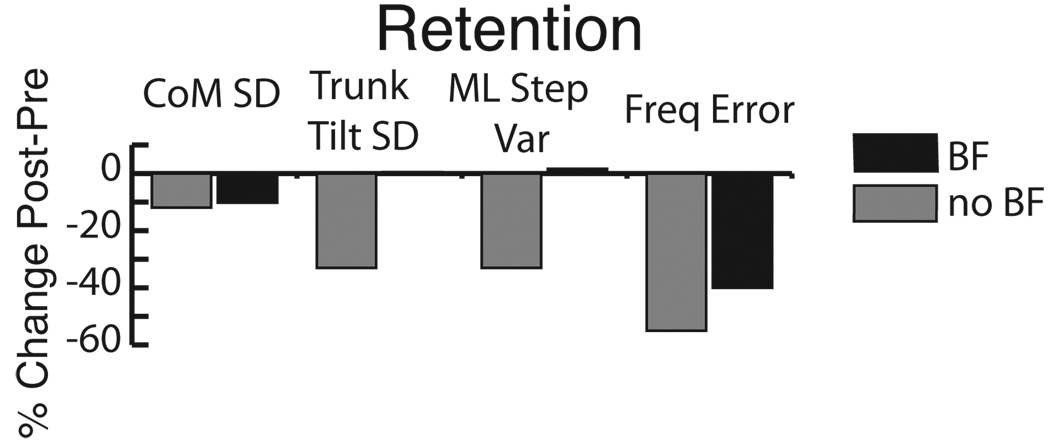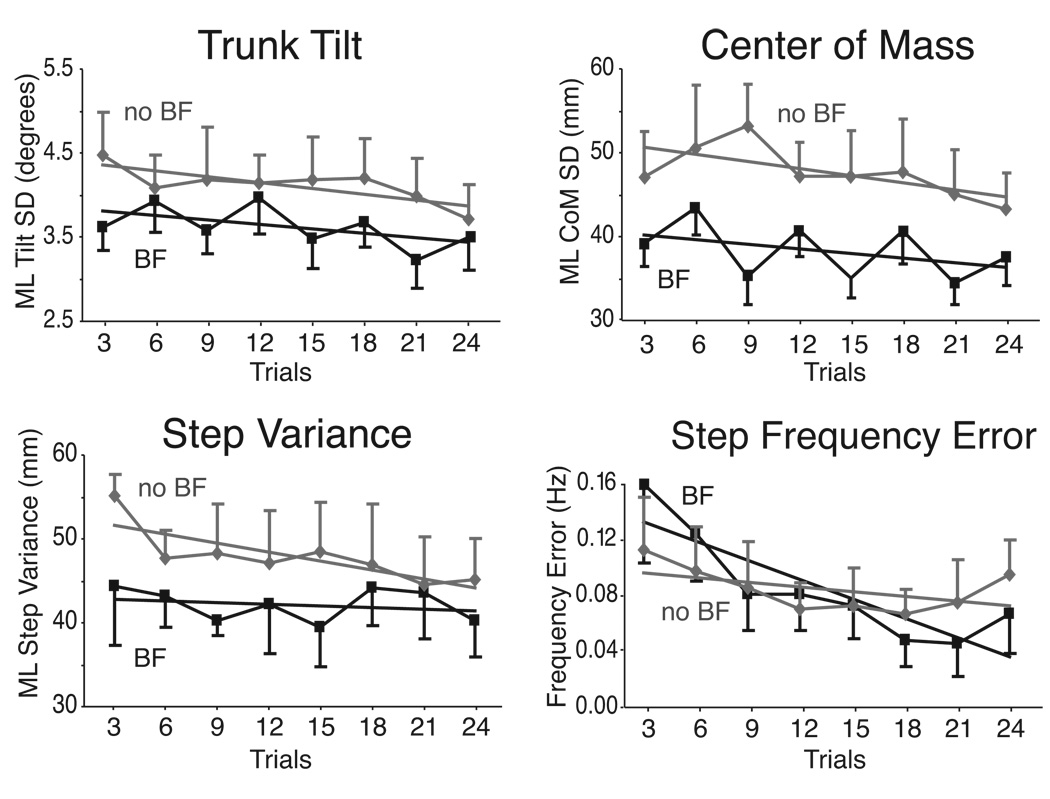Abstract
In a cross-over design, subjects with unilateral vestibular loss (UVL) practiced tandem gait with eyes closed on two days, two weeks apart, with and without vibrotactile biofeedback (BF) applied to the lateral trunk. Results showed an immediate improvement in postural stability (reduction of lateral center of mass displacement, trunk tilt and medial-lateral step width), that was significantly larger than effects of practice alone. However, BF did not increase the rate of improvement or retention of improved stability during gait.
Keywords: vestibular, biofeedback, balance, gait, posture
Introduction
Patients with UVL have difficulty standing and walking with narrow stance and eyes closed, even years after their lesion. Although studies have shown that sensory BF can reduce postural sway during quiet stance in patients with vestibular deficits, effects of BF on gait ataxia have not been reported.1,2 It is also unclear whether use of sensory BF to reduce postural instability can improve motor learning or retention of postural motor performance gained from practice. In this study, we compared the effects of practice alone with the effects of vibrotactile BF with practice on postural stability during narrow based gait with eyes closed in UVL subjects.
Methods
In a randomized, cross-over design, ten subjects with UVL practiced tandem gait (placing one foot directly in front of the other) with eyes closed along a 3-m walkway with and without trunk-tilt BF on two days, two-weeks apart, to test for retention. Subjects had 3 initial trials without BF, 45 trials either with or without BF, followed by 3 post-practice trials without BF. Step cadence was set to 30 beats per minute of a metronome. BF of lateral trunk tilt angle and tilt velocity was provided by a vibrotactile vest around the torso consisting of 2 columns of 3-tactors on each side (Audiological Engineering, Somerville, MA). The BF sensor, mounted on the right side at lumbar 5 level, consisted of a rate gyroscope and linear accelerometer that combined to form an estimate of the subject’s orientation to the vertical, accurate to 0.2 degrees.3 The tactors were inactive at zero velocity and initial trunk alignment and the lowest tactors activated when the tilt exceeded a 2-degree dead-zone, switching to the middle tactors at 7 degrees and to the highest tactors at 12 degrees. Postural stability during each trial was quantified from Motion Analysis markers as the standard deviation of the lateral trunk tilt angle, of the lateral center of body mass (CoM) displacement, and the medial-lateral mean distance between the feet during the double-stance phase. Gait motor performance was quantified as the mean frequency error of stepping compared to the metronome. All measures were averaged across the two cross-over groups to minimize order effects. Linear regressions were used to determine the significance of changes in performance across practice. An ANCOVA statistical analysis was used to determine whether changes in stability and gait across time were significantly different between trials with and without BF. Paired t-tests were used to determine short-term retention effects as the percent change of parameters before and after each 45-trial, practice session with BF or without BF.
Results
Tandem gait was very difficult for UVL subjects with large medial-lateral trunk movements, large base of support width and large variability of stepping time. Starting from the first trials, subjects consistently and immediately exhibited a smaller variability of trunk CoM, trunk tilt, and step width with BF than without BF (p<0.05). Figure 1 shows how lateral CoM displacement, trunk tilt, and mediolateral step width significantly decreased across practice trials with 60–70% of the variance accounted for by the linear regressions. Subjects’ stepping frequency error however, was not improved with BF. Percent improvement with practice alone and with BF together with practice was similar. Retention was better after practicing without BF than with BF (Fig. 2). That is, practicing with BF did not improve postural stability without BF immediately after a session.
Figure 1.
Effect of practicing tandem gait across trials with and without BF. Each value represents the average among ten subjects of three consecutive trials with standard errors.
Figure 2.
In contrast to practice alone (no BF, gray bars), practicing with BF (black bars) does not improve postural stability during tandem gait immediately afterwards (short term retention). Group mean percent change before (average of trials 1–3) and after (trials 28–30) practice with or without biofeedback. A significant retention of postural stability was seen in step frequency error after practice either with or without BF but Trunk Tilt SD and ML Step Variability showed retention only after practice without BF (near zero average % change post-pre practice trials with BF).
Discussion
As summarized here, Dozza et al, 2007 is the first study to show that BF of trunk orientation in space significantly improves ataxia of gait in patients with vestibular dysfunction.4 Every subject with UVL showed reduced lateral trunk tilt, reduced lateral CoM displacement and a narrower base of support during trunk vibrotactile BF than without BF, when attempting to tandem walk with eyes closed. Although BF immediately, significantly improved postural stability during gait, practice alone, without BF, also significantly improved tandem gait across a 45-trial session and adding BF did not increase this rate of improvement across trials. After practicing with BF, the effects of BF on tandem gait did not transfer to performance without BF. The different time frames of improvement (immediate with BF and gradually without BF) suggest that BF and training affect different, complimentary mechanisms of motor performance. Vibrotactile BF acts similarly to addition of natural sensory feedback (i.e.; vision or light touch) to improve dynamic postural stability by reducing sensory noise and not as a method to recalibrate the postural system to improve function without BF after short-term use.
Acknowledgement
Supported by NIDCD Grant 004082 to Fay Horak.
References
- 1.Dozza M, Chiari L, Horak FB. Audio-biofeedback improves balance in patients with bilateral vestibular loss. Arch Phys Med Rehabil. 2005;86(7):1401–1403. doi: 10.1016/j.apmr.2004.12.036. [DOI] [PubMed] [Google Scholar]
- 2.Dozza M, Horak FB, Chiari L. Auditory biofeedback substitutes for loss of sensory information in maintaining stance. Exp Brain Res. 2007 Mar;178(1):37–48. doi: 10.1007/s00221-006-0709-y. [DOI] [PubMed] [Google Scholar]
- 3.Wall C, 3rd, Oddsson LE, Horak FB, Wrisley DW, Dozza M. Applications of vibrotactile display of body tilt for rehabilitation; Conf Proc IEEE Eng Med Biol Soc; 2004. pp. 4763–4765. [DOI] [PubMed] [Google Scholar]
- 4.Dozza M, Wall C, III, Peterka RJ, Chiari L, Horak FB. Effects of practicing tandem gait with and without vibrotactile biofeedback in subjects with UVL. J. Vestibular Res. 2007;17(4):195–204. [PMC free article] [PubMed] [Google Scholar]




